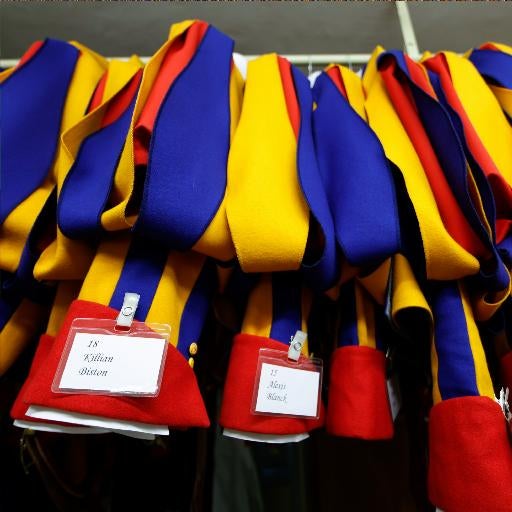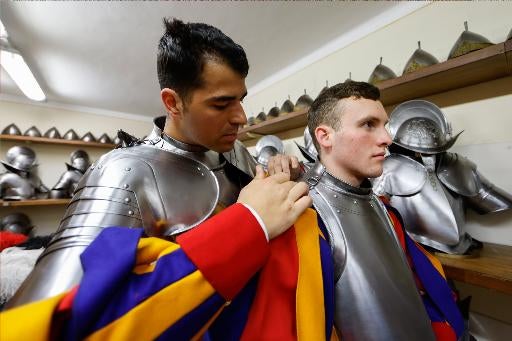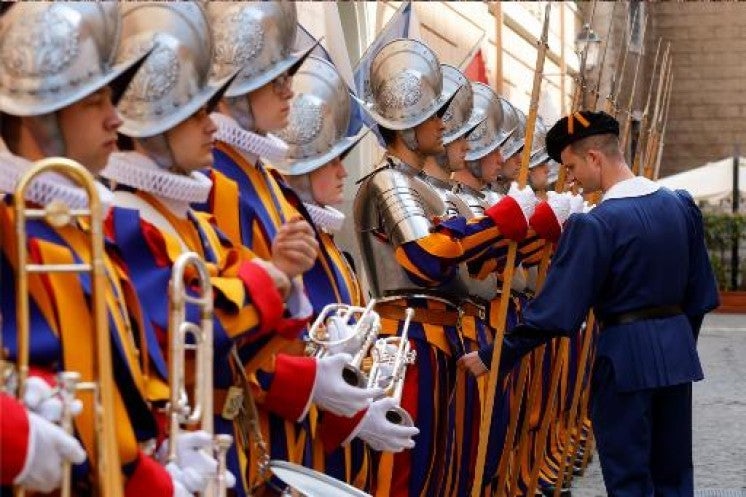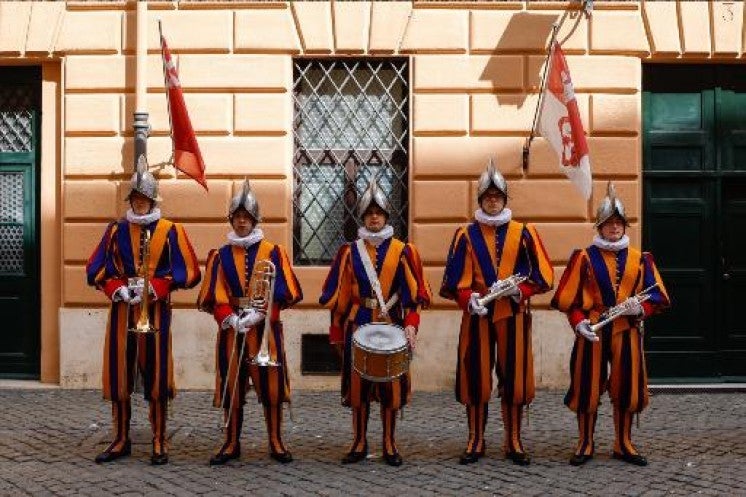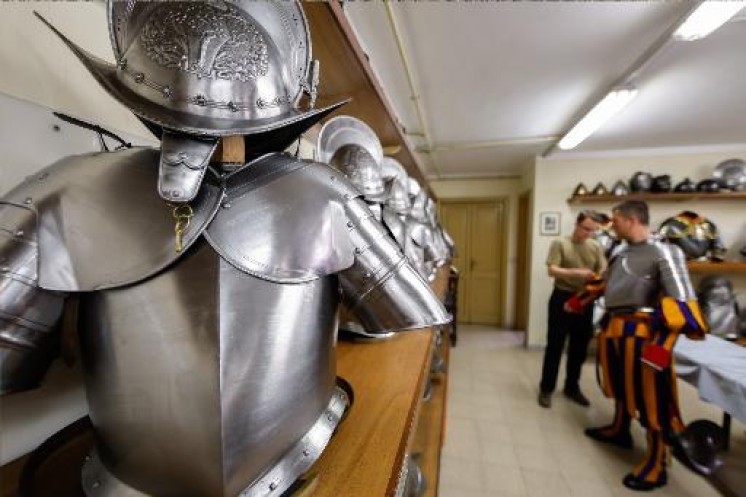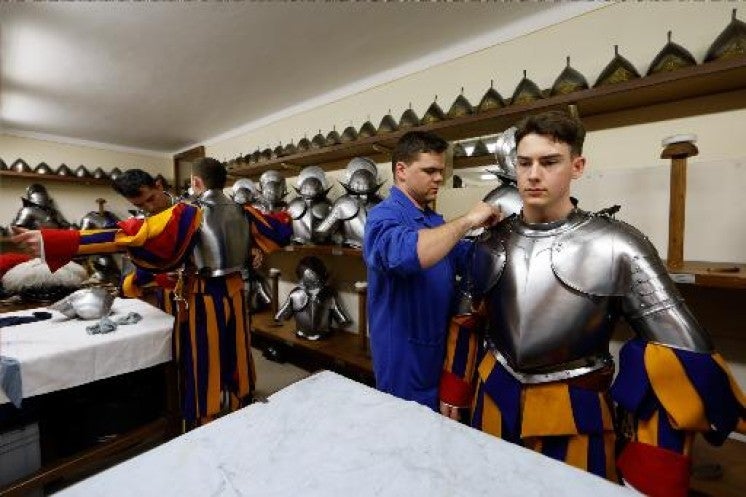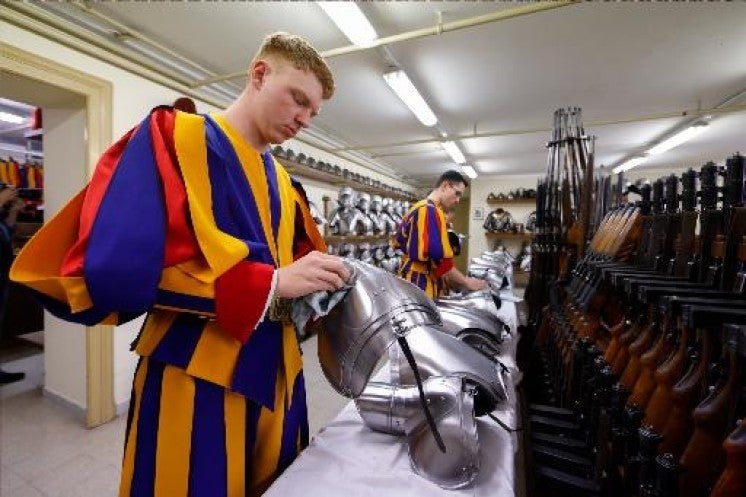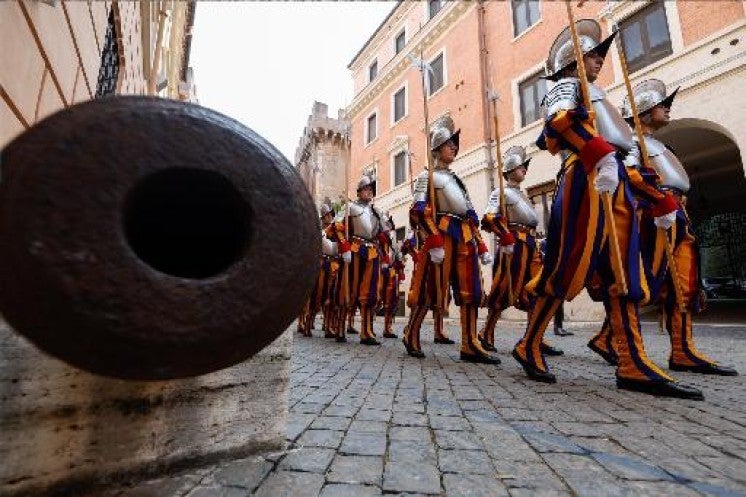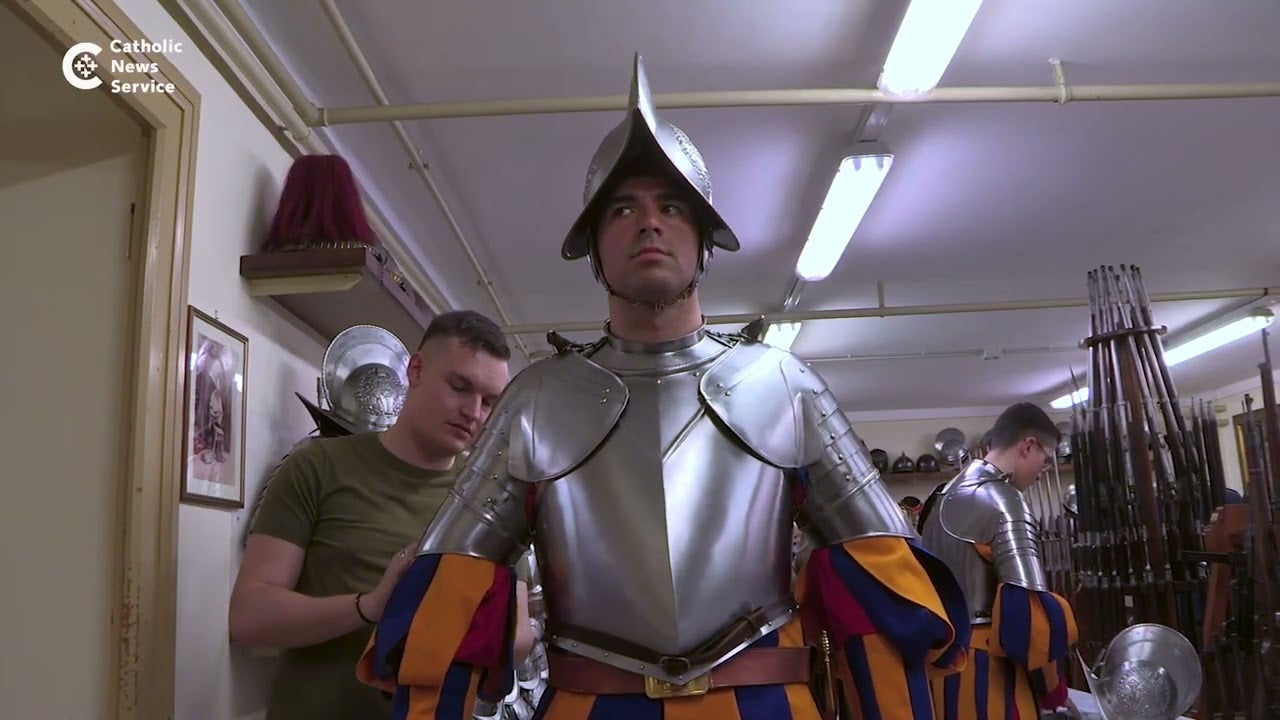Browsing News Entries
Columbia’s Catholic chaplain: Campus protests were pushed by ‘explicitly communist’ outsiders
Posted on 05/3/2024 21:05 PM (CNA Daily News)
 Father Roger Landry, Catholic chaplain at Columbia University, discusses the protests at Columbia University in New York City on EWTN’s “The World Over with Raymond Arroyo” on May 2, 2024. / Credit: EWTN News The World Over / Screenshot
Father Roger Landry, Catholic chaplain at Columbia University, discusses the protests at Columbia University in New York City on EWTN’s “The World Over with Raymond Arroyo” on May 2, 2024. / Credit: EWTN News The World Over / Screenshot
Washington, D.C. Newsroom, May 3, 2024 / 17:05 pm (CNA).
Father Roger Landry, a Catholic chaplain at Columbia University, said on Thursday that the protests making national headlines at the New York City school are being organized in part by “explicitly communist” outside forces.
“There is an instrumentalization of what’s going on in Gaza to advance an agenda,” he said. “And that is to deconstruct our present world order at which the United States is considered the top of that order.”
Speaking on EWTN’s “The World Over with Raymond Arroyo,” Landry said that he had been walking through the encampment nearly daily, conversing with student protesters and other “outside agitators.”
While he said he believes that many of the protesters were genuinely concerned for Gazan civilians, there was a sizable percentage of whom were “explicitly in favor of Hamas” and “definitely antisemitic by their language and their actions.”
What is going on at Columbia?
The Columbia demonstration began on April 17 when a large group of students set up dozens of tents to occupy the university’s main quad. Protesters at the encampment said they were standing against Israel’s “genocide” against Palestinians in Gaza.
Many videos circulated online of protesters shouting antisemitic chants and calling for the destruction of Israel, and some Jewish students have reported being threatened by protesters.
One Jewish student’s perspective from Columbia University 👇 @NewsNationComms pic.twitter.com/X7307dW2EJ
— Elizabeth Vargas (@EVargasTV) April 27, 2024
Clad in riot gear, officers from the New York City Police Department cleared the encampment in a Wednesday raid that resulted in several hundred arrests.
Similar protests and encampments on campuses across the country, many of which are still ongoing, have taken place since the demonstration at Columbia began.
Marxist ideology at heart of protest
According to Landry, nearly half of the approximately 300 protesters arrested were non-student activists.
He said these outside forces are “explicitly communist groups” who have been distributing Marxist materials attacking the state of Israel since the Hamas Oct. 7, 2023, terrorist attack.
Landry said that these materials attempt to justify the Hamas attack “out of this neo-Marxist, ‘oppressor versus oppressed’ ideology that says whatever somebody in the category of ‘oppressed’ wants to do against a so-called ‘oppressor’ is justified, even killing way more than a thousand innocent people at a party.”
“This divide and conquer class warfare that comes from Marx and Lenin is the exact antithesis of what Jesus Christ himself taught,” he continued. “So, I try to get the Catholic students aware of that problem so at least they’re inoculated to that intellectual virus.”
Catholic students act as peacemakers
Landry said he was proud of the many Catholic students who have “stepped up” to be peacemakers amid all the hatred on campus.
He said that student Mass attendance has increased on campus. A Catholic student group sent symbolic olive plants to both Jewish and Muslim leaders at Columbia to show the “solidarity and peace of Christ,” he said.
“Transcending the moment but also incarnating ourselves in the moment, [we] are trying to bring the peace we have received from Christ that our world and our campus very much need,” he said.
Watch the full interview with Landry on “The World Over” below.
Biden awards Presidential Medal of Freedom to Jesuit priest for work with youth
Posted on 05/3/2024 19:30 PM (CNA Daily News)
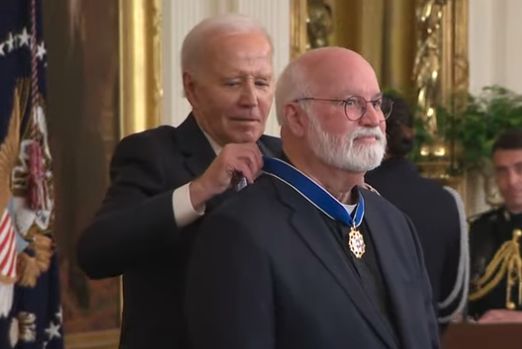 President Joe Biden presents the Presidential Medal of Freedom to Jesuit Father Greg Boyle on May 3, 2024. / Screenshot/public domain
President Joe Biden presents the Presidential Medal of Freedom to Jesuit Father Greg Boyle on May 3, 2024. / Screenshot/public domain
CNA Staff, May 3, 2024 / 15:30 pm (CNA).
The White House on Friday announced that Jesuit Father Greg Boyle, the founder of a prominent ministry dedicated to rehabilitating gang-affiliated youth, will receive the Presidential Medal of Freedom alongside 18 other recipients this afternoon.
Boyle, ordained a priest in 1984, founded Homeboy Industries in 1992 while pastor of Dolores Mission, a Catholic church and school in an area that at one time had one of the highest concentrations of gang activity in Los Angeles.
Today, Homeboy Industries claims to be the largest gang-intervention program in the United States.
The successful ministry, which now operates nationwide, offers training and job skills to those formerly involved in gangs or in jail, as well as case management, tattoo removal, mental health and legal services, and GED completion.
While the group has said it is “not affiliated with any particular religion,” it also notes that many of its works are “in line with the Jesuit practice of social justice,” and Boyle has said that the organization does not seek to “downplay” its Catholic identity.
Boyle described the ministry several years ago to CNA as “soaked with the Gospel.”
The Presidential Medal of Freedom, the nation’s highest civilian honor, is presented to individuals who have made exemplary contributions to the prosperity, values, or security of the United States, world peace, or other significant societal, public, or private endeavors, the White House says.
In announcing this year’s recipients, the White House noted that the honorees “built teams, coalitions, movements, organizations, and businesses that shaped America for the better.”
“They are the pinnacle of leadership in their fields. They consistently demonstrated over their careers the power of community, hard work, and service,” the announcement says.
Biden, who is Catholic, announced that among the honorees is former Speaker of the House Nancy Pelosi and former Secretary of State John Kerry, both fellow Catholics known for their pro-abortion advocacy.
Other honorees this year include former New York Mayor Michael Bloomberg, former Vice President Al Gore, Olympian Katie Ledecky, and actress Michelle Yeoh.
In 2020, Boyle was one of several hundred religious leaders who signed an endorsement of Biden’s campaign. The priest has called for the Church to “include with more compassion our LGBTQ sisters and brothers.”
In 2021, meanwhile, Homeboy Industries received $20 million in grants from prominent progressive backers Mackenzie Scott and Dan Jewett.
The prayer of a holy journalist before dying for the freedom of the Catholic press
Posted on 05/3/2024 17:45 PM (CNA Daily News)
 Martyred by the Nazis, Dutch St. Titus Brandsma was a journalist who gave his life so that the truths of the faith would not be silenced. / Credit: Wikimedia Commons
Martyred by the Nazis, Dutch St. Titus Brandsma was a journalist who gave his life so that the truths of the faith would not be silenced. / Credit: Wikimedia Commons
CNA Newsroom, May 3, 2024 / 13:45 pm (CNA).
World Press Freedom Day is celebrated every May 3, drawing attention to the importance of free and independent news media.
Among modern-day saints, there is a journalist-priest who suffered martyrdom by the Nazis for his work in Catholic media: St. Titus Brandsma.
St. Titus (1881–1942), canonized by Pope Francis in 2022, was a Carmelite priest and native of the Netherlands. During the Nazi occupation of that country, the Nazi public relations bureau informed Dutch newspapers that they had to accept advertisements and press releases emanating from official sources.
The cardinal-archbishop of Ultrecht, Johannes de Jong, commissioned Brandsma, in his capacity as a journalist and spiritual director of the country’s Catholic journalists, to convey the hierarchy’s response to the Nazis’ mandate to all the Catholic editors in the country.
Brandsma concluded each visit to the editors with remarks along these lines: “We have reached our limit. We cannot serve them. It will be our duty to refuse Nazi propaganda definitely if we wish to remain Catholic newspapers. Even if they threaten us with severe penalties, suspension, or discontinuance of our newspapers, we cannot conform with their orders.”
Brandsma visited 14 editors before the Gestapo arrested him. He was arrested and taken to the Amersfoort penal camp, where he was made to work in inhumane conditions. Later, he ended up in the terrifying Dachau concentration camp in Germany, where the regime carried out experiments on prisoners. He was ultimately killed with a lethal injection of carbolic acid.
Before dying, he gave his rosary to the nurse who injected him with the deadly substance. She told him that she did not know how to pray, and he replied that she should only say: “Pray for us sinners.” Some time later the young woman converted and was a witness in the canonization process of Brandsma.
His body was never found and it is believed that he was cremated in the ovens of the Nazi extermination center. St. John Paul II approved the decree recognizing his martyrdom, and he was beatified in 1985. Pope Francis canonized him on May 22, 2022.
According to the Dutch newspaper Nederlands Dagblad, dozens of international journalists and the 520-member German Association of Catholic Journalists signed a letter to Pope Francis asking him to name St. Titus Brandsma as patron of journalism.
For their part, the Carmelites indicate that the saint wrote a special prayer between Feb. 12–13, 1942, when he was in prison titled “Before an Image of Christ”:
O Jesus, when I gaze on you
Once more alive, that I love you
And that your heart loves me too
Moreover as your special friend.
Although that calls me to suffer more
Oh, for me all suffering is good,
For in this way I resemble you
And this is the way to your kingdom.
I am blissful in my suffering
For I know it no more as sorrow
But the most ultimate elected lot
That unites me with you, O God.
O, just leave me here silently alone,
The chill and cold around me
And let no people be with me
Here alone I grow not weary.
For thou, O Jesus, art with me
I have never been so close to you.
Stay with me, with me, Jesus sweet,
Your presence makes all things good for me.
This story was first published by ACI Prensa, CNA’s Spanish-language news partner. It has been translated and adapted by CNA.
Chicago priest blesses same-sex ‘spouses,’ says Fiducia Supplicans allows it
Posted on 05/3/2024 17:00 PM (CNA Daily News)
 null / Gutzemberg / Shutterstock
null / Gutzemberg / Shutterstock
CNA Staff, May 3, 2024 / 13:00 pm (CNA).
A priest in Chicago last month blessed a same-sex couple, saying that the Vatican’s recent document Fiducia Supplicans authorized such blessings.
Father Joseph Williams, the pastor of St. Vincent de Paul Parish near downtown Chicago, is seen in an April 22 video shared on Instagram by Kelli Knight, a Methodist minister and self-identified “queer” community organizer.
In the video, Williams is seen in the parish with Kelli and Myah Knight. “Myah always wanted to get married at the chapel of her alma mater, so I surprised her with a blessing of our marriage!” Kelli wrote in the post. The parish is affiliated with the Catholic DePaul University in Chicago.
In the video, Williams can be seen asking the couple: “Kelli and Myah, do you freely recommit yourselves to love each other as holy spouses and to live in peace and harmony together forever?” The two women respond, “I do.”
“Loving God, increase and consecrate the love which Kelly and Myah have for one another,” the pastor then says. “The rings that they have exchanged are the sign of their fidelity and commitment.”
“May they continue to prosper in your grace and blessing,” he added.
“May God’s blessing be yours, the Father, the Son, and the Holy Spirit, amen,” the priest finished.
Neither the priest nor the Archdiocese of Chicago immediately responded to requests for comment from CNA on Friday morning. The pastor told OSV News that his understanding of Fiducia Supplicans is that “same-sex couples can be blessed as long as it does not reflect a marriage situation … as long as it’s clear that it’s not a marriage.”
He reportedly told Knight when she first inquired about the blessing: “Please understand that this is not in any way a marriage, a wedding, anything like that. This is just simply a blessing of persons.”
Fiducia Supplicans has generated global controversy since it was first promulgated last December. The Vatican at the time directed that Catholic priests can bless same-sex couples as an expression of pastoral closeness without condoning their sexual relations.
Bishops around the world in the subsequent months have been deeply divided over the declaration. Some prelates have responded warmly to the directive, while others have said they will not implement the practice.
Cardinal Pizzaballa: Peace in Holy Land built on dialogue, action
Posted on 05/3/2024 16:21 PM (CNA Daily News)
 Cardinal Pierbattista Pizzaballa gives the homily at a Mass in which he took possession of his titular church, St. Onuphrius, in Rome on May 1, 2024. / Credit: Vatican Media
Cardinal Pierbattista Pizzaballa gives the homily at a Mass in which he took possession of his titular church, St. Onuphrius, in Rome on May 1, 2024. / Credit: Vatican Media
Rome Newsroom, May 3, 2024 / 12:21 pm (CNA).
The Latin patriarch of Jerusalem delivered an impassioned lecture on Thursday at the Pontifical Lateran University in Rome detailing the process of peace in the ongoing Israel-Hamas war, noting that it is an integral part of the Church’s universal mission and one that must not be conflated with overtly temporal or political aims.
“Peace needs the testimony of clear and strong gestures on the part of all believers, but it also needs to be announced and defended by equally clear words. We cannot remain silent in the face of injustices or invite people to live peacefully and disengage,” Cardinal Pierbattista Pizzaballa remarked during his “lectio magistralis” on Thursday at the pontifical university.
“The preferential option for the poor and the weak, however, does not make us a political party,” he added.
The hourlong lecture, titled “Characteristics and Criteria for a Pastoral Care of Peace,” was the latest installment in the university’s ongoing series of studies in peace sciences and international cooperation launched by the school’s Pontifical Pastoral Institute Redemptor Hominis.
The cardinal stressed that the Israel-Hamas conflict is not just an issue for the local Church but also an issue for the universal Church.
“What I tend to say is that conflict is not a temporary and secondary issue in the life of our Church,” the cardinal continued; rather, he said, it “is now an integral and constitutive part of our identity as a Church.”
Pizzaballa underlined that “talking about peace, therefore, is not talking about an abstract topic but of a deep wound in the life of the Christian that causes suffering and tiredness, a lot of tiredness, and deeply touches the human and spiritual life of all of us.”
Stressing the universality of the conflict, he added it “involves the life of everyone in our diocese and is therefore an integral part of the life of the Church, of its pastoral care.”
The day before the lecture, Pizzaballa took possession of his titular church in Rome, St. Onuphrius, where he spoke on the historic, symbolic, and theological links between the Church in the Holy Land and Rome, again expressing the importance of the Holy Land for the universal Church.
“The Church of Jerusalem is the mother Church of the Church, where the roots of the entire universal Church lie, and it is a place that still retains a local and universal character today,” he said during his May 1 homily.
In his lecture on Thursday, Pizzaballa made overtures to the historical roots of the conflict in order to stress the “plurirelgious” and “pluricultural” nature of the Holy Land and to open a reflection on the importance of narrative in the process of peace.
“These problems of memory cannot be solved by reading one’s own history,” he said. “Intercultural conflicts will not be overcome if we do not reread different readings of the strong religious and cultural histories.”
While arguing that “peace is not the exclusive responsibility of the pastor,” he noted that religious leaders must work to “create contexts in which communities can express themselves.”
“Today, especially in the Holy Land, everyone has their own little story to tell,” he added.
Pizzaballa stressed the importance of dialogue as a critical underpinning of the peace process, noting that through the promotion of “continuous dialogue” and “mutual listening” that “a serious pastoral care in peace is born and developed.”
The cardinal also noted religious leaders must work to promote both “a new culture of legality” as well as to “become a living and prophetic voice of justice, human rights, and peace.”
While acknowledging that there has always been “a close relationship” between ecclesial and civic leaders, playing a delicate role in the “function[ing] in the life of national communities,” Pizzaballa warned that the Church’s call for peace must exist “without entering into logics of competition and division” in order to offer “credible witnesses.”
Cardinal Goh of Singapore: ‘Deep encounter with Jesus’ is key to passing on the faith
Posted on 05/3/2024 10:00 AM (CNA Daily News)
 The spiritual shepherd of the Church in Singapore is Cardinal William Goh, archbishop since early 2013 and a cardinal since 2022. / Credit: Sean Boyce/EWTN News
The spiritual shepherd of the Church in Singapore is Cardinal William Goh, archbishop since early 2013 and a cardinal since 2022. / Credit: Sean Boyce/EWTN News
National Catholic Register, May 3, 2024 / 06:00 am (CNA).
Pope Francis recently announced his intention to travel to Southeast Asia in September to visit Indonesia, Papua New Guinea, East Timor, and Singapore. The island nation of Singapore is one of the most ethnically and religiously diverse regions in Asia and is home to about 395,000 Catholics. The small but strategically important nation also has the highest urban density in Asia but is ranked as the country with the highest quality of life. Like everywhere else, it also faces the threats of secularism and relativism and a loss of traditional values, especially a commitment to family and respect for the elderly.
The spiritual shepherd of the Church in Singapore is Cardinal William Goh, archbishop since early 2013 and a cardinal since 2022. He sat down in his residence in Singapore on April 19 with Matthew Bunson, EWTN News’ vice president and editorial director, to discuss the Holy Father’s upcoming trip, the College of Cardinals, the synodal process, and the challenges and opportunities for the Church in Asia.
In the following edited transcript, Goh, 66, observes that “most of us” in the College of Cardinals “do not know each other,” a disadvantage for a body that will one day be called upon to choose a successor to Pope Francis. The cardinal also suggests the need for “another level” to the Synod on Synodality beyond its second and final assembly this October — namely a bishops-only synod. The existing synod, which includes bishops, clergy, and laypeople, “cannot really be considered a theological dogmatic synod,” he says, because not all of the delegates are theologically trained.

Your Eminence, I’m so grateful for your time. I know that you’re a very busy man, even busier now with the announcement that Pope Francis is going to be visiting Singapore. I’d like to start with a question about yourself. You are a native Singaporean?
Yes.
Could you talk about your faith journey, especially leading to the priesthood, to being a bishop, and now to being a member of the College of Cardinals?
My faith journey is really from hindsight. When I look at my life, it’s really a faith-filled journey, but truly a grace of God. My family is not extremely religious, except perhaps for my mother. But when I was young, being an introvert, instead of joining my fellow classmates to play before class, I would go to the church to pray the rosary, at the age of 7. At the age of 12, I was bringing the Divine Office, although I didn’t know what it was all about. And then I joined the altar servers. I was also in the Crusaders. And then we started the Rosary Club, where 100 young people would come every evening in the school. … During the recess, they would come to pray the rosary, 60 of them; instead of going for their recess, for their food, they came to pray. And then later on, I was very much attracted to this vocation, and I joined the seminary; and then I was ordained, and then I was assistant priest for a few years, and then they sent me to Rome for further studies. [When] I came back, I taught in the seminary for 22 years.
I held all the different positions in the seminary, from dean of studies right up to rector. That was my last position, and then I was appointed bishop. But parallel to what I was doing, I was also appointed as the spiritual director of the Catholic Spirituality Center; this was the Charismatic Renewal. So I’m very much in the renewal movement. And so I conducted conversion-experience retreats. This will be the 60th session I’ve been conducting, and one retreat is about five days.
.... So my own conversion experience, I must say, came about because I conducted the conversion-experience retreat, because I came to really be in touch with the sufferings of people, the real life, the struggles as Catholics; because during that retreat, they all make, I always call [it] “deathbed confession.” They are properly prepared for confession, and it is really heartwarming, and it changed my whole perspective on life, very different from my life in the seminary. As a professor, you are always teaching, you are always reading, and it is more theoretical; but, here, it really helps me to put theology into practice. On hindsight, really, when I look back at my life, God has always been guiding me.
How did you learn that you had been named a member of the College of Cardinals?
Just like all the other cardinals, because [of] Pope Francis, his way of announcement at the Angelus. And so somebody sent me an SMS, “Your name has been mentioned.” I couldn’t be bothered, you know; I was so busy preparing a homily. Then a few more SMS messages came in. Then I realized…
You had no idea that this was coming, obviously. What has the experience been like to be a member of the college, with all of the responsibilities, but that particular relationship with the Diocese of Rome?
Well, certainly as a cardinal, we have a greater responsibility to the universal Church. But so far, I’ve just attended only two consistories and one meeting because I belong to, I’m a member of the Dicastery for Family and Life. That is the connection so far. So I think to be chosen as a cardinal, and I think what Pope Francis has been doing, I mean, it’s a good idea. … The Church should be inclusive, to be universal. We have cardinals from all over the world. But I think the difficulty, the challenge would be getting the cardinals together to know each other well, especially when the time comes for voting for the pope for the conclave. That would be necessary. But, presently, I think most of us do not know each other and not all speak Italian, as well. So I think that area of rapport among the cardinals would be necessary for greater communion.
You mentioned Pope Francis. He’s coming to Singapore. What does his visit here mean? I know that John Paul II was here very briefly in 1986. First, what was that experience like? And what are your hopes for Francis’ visit?
Well, Francis is always popular with many of our Catholics, and I think he is a beacon of hope, a beacon of mercy and compassion. That is his forte, really, to try to continue the work of Pope St. John Paul II, Pope Benedict. The theme of evangelization is very dear to the heart of Pope Francis, but his way of evangelization is really to proclaim the joy of the Gospel, which includes welcoming people, being with the poor, with the marginalized. So, in that sense, he will be able to promote greater unity and strengthen the faith of our Catholics and also to inspire people of other faiths, that the Church is not inward-looking, but we are actually at the service of humanity. So I believe that his coming will certainly not just inspire and renew the faith of our Catholics, but also people who listen to him and people who are very appreciative of Pope Francis. In fact, the religious, the non-Catholic religious, leaders here, they are all very appreciative of Pope Francis, and they speak highly of him.
We’re reaching the conclusion of this long process of synodality. I know that you attended the Synod of Bishops last October. What was that experience like?
What I like about that synod was the retreat and the small-group sharing — in that group sharing, we truly were able to journey with each other, listen to each other, without judgment, and accompany each other, especially when we are among bishops. It’s much easier because we understand our own struggles and difficulties and challenges and also aspirations. That’s the good thing about the synod. And I think that is the way, not just for the universal Church, but also for the particular Church, local Church, that we need to listen to, journey with each other. I think that is very helpful, so that there will be a greater understanding and communion between the clergy and the laity, so that we walk as one, so that we will truly be coming together as one Church.
But the synod, I think that, for me, is really great. That is the most important thing. I benefit from the synod. But when you have a plenary assembly where everybody is giving intervention [talks], that becomes a little bit more sensitive, because we are not able to be as open or direct as you wish to be … for fear that you might offend people who have other views.
So it needs a lot of courage to state what you need to say and be open about it. But I suppose there is also a subtle pressure that what we say, if it is not appreciated by some quarters, may not go very well. So I think that is also a subtle pressure. And I think, most of all … at the end of the day, although it has been underscored that the synod is not a parliamentary session, which it is not, but there is voting at the end. So the voting, so in the mind of people, although it is not a parliamentary session, but I think most people would take the votes as a kind of consensus making. Of course, at the end of the day, it’s the Holy Father who takes the decision; that’s what he has done. So I think, in the area of consultation, it is helpful for the Church, and I think it’s very important also for the prelates to listen also to the laity. But as has often been said, or some bishops are suggesting, perhaps there should be another level where it is really a Synod of Bishops, after hearing the laypeople, after journeying with them; there should be that level of bishop synods, where the bishops can come together, because that synod [with laity] cannot really be considered a theological dogmatic synod, because not all are theologically trained.
All those who vote are not theologically trained. So you might need to have another level, where it is just basically bishops, with the Holy Father, to determine certain doctrinal issues. In terms of pastoral outreach, I think for that kind of synod, it would be helpful; but when it comes to doctrines, I think it’s a bit different.

And the Christian population here makes, I think, about 19%, 20% of the total population. Is that right? What are the opportunities for ecumenical outreach for Catholics, but then also interreligious dialogue here? This seems a very rich place for that.
Yes, this is something unique in Singapore. We try to make Singapore an icon for ecumenism and interreligious dialogue. But I think, and I did share with many people, that it’s a bit difficult for other countries to duplicate what we are doing in Singapore. We have excellent religious, harmonious relationship with all the other religions. We know the religious leaders all by name, and we know them as friends. And so we do not have any issues. Anything we have, we will speak to them. We are all very friendly and supportive of each other. We visit each other for their religious celebrations. We are present for meetings quite often, and we share, and there is a lot of mutual respect, appreciation — and also the fact that, in Singapore, we have a law that forbids anyone to speak ill of another religion. That helps a lot, and so that makes everybody respectful because it is very sensitive. So, in that sense, there is already a lot of interfaith sharing among Catholics, among religious leaders. In terms of ecumenism, we are on very good terms with the Christians, and we are supportive of each other. So, of course, we could do more, you know, but I started an office … an archdiocesan [office] for interreligious dialogue and also ecumenism. But our resources are limited. And also my time is limited. I cannot be everywhere. I try my best, according to whatever time that I have to reach out to the Christians and especially to the non-Christians.
The Church here, like the Church everywhere, is facing pressures from secularism, relativism. You’ve spoken about the importance of defending … I think you use the phrase “truth and justice.” What does that mean?
It’s important for us that, in the face of this secularism or the -isms, individualisms and so on, I think the Church has to be truthful in what we proclaim. I do not believe that we should make the Gospel message [different] or dilute the Gospel message. The truth has to be spoken because the truth sets us free. But, of course, truth has to be spoken with charity. That is very important. But I don’t believe that we should try to compromise the Gospel. And that is my fear: that, today, even Church leaders are compromising the Gospel. I don’t think Jesus ever compromised the Gospel, even for the adulterous woman. He says, “I do not judge you, I do not condemn you, but please sin no more.” I think that has to be mentioned. This is where the importance of truthfulness, mercy, and compassion [comes in].
You look at the world today: There is so much injustice. So what can we do? In some countries, not in Singapore, because I am a member of the FABC [Federation of Asian Bishops’ Conferences], in some countries, they are being persecuted because of their religion, sometimes because of their race, by political authority.
So how do we speak with those people in authority? How do we dialogue? So I think this is where, again, I think Pope Francis, I think his direction is certainly the direction we need to follow. Dialogue. We need to dialogue. We need to listen; we need to dialogue. We need to strengthen trust because, at the end of the day, we are all for the same goal. Humanity is all for the same goal: We want happiness, but not happiness, only true happiness. We don’t want just love. We want fruitful love.
Singapore has been described as a kind of bridge between the West and the East. What can Singapore show, and what can this region show, to the wider Church, in terms of harmony, but also the direction that you think we need to go?
Actually, Singapore is more in the first world [as a] country than the rest. That’s why, when I attend FABC meetings, FABC, although it’s a Federation of Asian Bishops conference, but actually the whole world is there, because countries are very affluent, … and some are poor; some [there is] a political issue, some religious suppression. So it’s very diverse. So, in that sense, a bit difficult. But for us as a Church, I think Singapore can be a model, in terms of: How do we remain faithful in our faith in an affluent country? Because the challenges facing Singapore is basically a first-world problem. So we could identify very much with Europe; whereas the problems that Europe is facing is not the problem of Africa or Asia, in general. So it is sometimes a continental issue rather than the issue of the universal Church. So, like in Singapore, what I think we can do is really help to promote religious harmony. That is our strength because of the work that we have been doing — and especially to help governments. In Singapore, the beautiful thing about our government is we see ourselves as a multiracial, multireligious country. We are not a secular country.
We have a secular government, yes, to ensure fairness, impartiality; and even most of the members in the government, they belong to some faith, and they are very staunch in their faith. But I think this is where Singapore can show the way: how, even in a very cosmopolitan country, very diversely religious country, we can live together. So long as there is respect, sensitivity to each other, then I think we can work together. And Singapore has so many races, as well, so many ethnic groups of people; we can live together as one, so that, for us, I think [we have] a forte [to model] for other countries in the world, [showing] how to live harmoniously. I think you need to have a good government, a strong government to be able to support the work of the religions and all the NGOs.
So that relationship between the Church and state has to be respectful.
Yes. And in Singapore, the state sees us as partners, which is true. We are partners with the government for the same reason, because it’s for the common good of the people. We take care of their spiritual needs; we help the government to make sure that they rule justly. We express our views, and the government is very grateful. When they have certain issues, moral, social issues, they will consult the religious leaders. Of course, at the end of the day, they have to make the decision. I mean, it is a multireligious country.
Asia is one of those parts of the Church, like Africa, where the Catholic population is growing. Do you see the importance of Asia increasing in this century? And, if so, what can the rest of the Church learn from Asia as an experience? I know that we’re talking about a very diverse set of cultures and countries, but the Church does seem to be growing here, and it’s very vibrant.
I would say that, and this is my assessment, I think the problem with established Christian countries, like Europe, for example, faith, I think, has become too institutional. Religion has become ritualized. It becomes routine; it becomes a custom, even. It is not a personal faith. They don’t have this personal encounter with Jesus. In Asia, because many of us are converts, at least for the last two, three generations — and to convert from one faith to another, it’s not an easy thing; you will be marginalized initially — and so these people, not only have they studied about the faith, most of all, they have encountered Jesus. And that is what my conversion-experience retreat tries to do. Actually, the conversion-experience retreat, at first, [when] I started, it was meant for lapsed Catholics. I wanted to bring back the lost sheep. Then, after that, a lot of members in the Church [say], ‘We also never experience God. We also want to join,’ so it becomes for all now. But I believe that when we get a person to encounter Jesus personally, Jesus is real; Jesus is alive. They can encounter his mercy, his love, his forgiveness. Their life will change.
And I honestly believe all these ideological struggles, whether it’s gender ideology, same-sex, all this abortion, euthanasia — all this comes about because you are operating on the level of the head. On the level of the head, you can twist and turn. You can argue from every side. For us who are Catholics, if you encounter Jesus, you know he is your Lord and Savior. You will accept whatever is taught in the Scriptures. You will live your life according to what Jesus has lived and has taught, even though you might not agree — because we have faith in Jesus. So, my pastoral approach in dealing with people who are disagreeable with the Church is … we cannot force our doctrines on these people. I invite them to know Jesus. I invite them to fall in love with Jesus. And I believe Jesus will take care of them — and Jesus will. Because if you love Jesus so deeply, surely you want to live like him. … Who are those people who are grumbling about certain moral issues of the Church? These are all … nominal Catholics, because they have no faith.
So your message to them is: Jesus?
Yes. We need to have a personal relationship, and the Church has to provide the opportunity, so it’s not just preaching, teaching; that is important, but that comes after. So even in the early Church, what do we do in the early Church? “Didache” comes after being evangelized. So the “kerygma” has to be preached first; then “Didache”; then the teaching. But we are putting the cart before the horse. We are teaching, and hopefully they receive the “kerygma.” … That is also my fear that the young people today, they don’t … because if they are brought up from a traditional Catholic family and if the parents are weak in their faith after confirmation, as Pope Francis will always say, it’s a farewell [to faith] — bye-bye. Because they have no faith; we call it a routine faith. It is not real faith. So what we try to do now, even for young people, is also to give them a deep encounter with Jesus. And we have the office of young people doing parallel to what I’m doing for the adults. We give them a good experience of Jesus. Their lives change.

With so many influences on young people, you’ve mentioned this office being developed. Your message to young people today, what is your immediate message to somebody who’s being challenged by social media, by the secular influences?
What I feel that is most important for young people: We need to build faith communities. They need to be supported in their faith. And that is the reason why, in order to keep the young people within the faith, we need to help them to form faith communities where they can support each other. So two things for me are critical in helping our young people to deal with all the challenges in the world: an encounter with Jesus; belonging to a faith community. And they will grow. As their faith grows, they will know what to do and how to deal with all these, you can say, challenges, in society. And, of course, I think there is also an important part to play … after “kerygma” is “Didache.” But then also we need to continue to preach and to teach. One of the reasons why young people have left the Church is because they feel that they cannot connect with the Church; they cannot connect with the doctrines of the Church. And we need to have more theologians, lay theologians perhaps, to be able to be the bridge between the ecclesiastical language and the ordinary language.
The problem is that we are trained in theology and Scripture. We tend to use this kind of ecclesiastical language. For us, it’s our — what do you call it? — our cup of tea. You know, we use that language so often that we don’t realize the people in the world don’t understand what we’re talking about. And so we cannot connect with the young people. So I think we need to have a bridge. And this is where all the social media and all these things will try to make it more palatable for young people to understand, to appreciate, and to be able to share with their friends.
Your Eminence, the last question I have is on one of the things that’s very clear in Singapore: the importance of family. Pope Francis talks about respecting the generations, of having those bridges from the old to the young. What is the secret here? Why is that still so much a part of life here? And what is a lesson there for other cultures to learn?
I think generally, not only within the Catholic Church definitely, generally Asian society, we tend to be focused more on the family. Family piety, filial piety, all these are very important. But that is also being eroded away because of the Western influence; because of affluence, because people want to have a better life, they will live, they will migrate, and parents both are working, in order to have a better life. Cost of living is high. So there are a lot of threats against the family, even in Singapore, although we are trying to protect the family. We have many — I think we have 11 — organizations that deal with family life. So we have to work hard at it. I won’t say that we are doing extremely well, but because we belong to this Asian culture, that family dimension is always important; but we need to protect it, because I think, with affluence, that family is being threatened. And because parents are all working, and the children, we have small families. In fact, we are below replacement of the population, as well. And then the younger people, they are not interested in having families. ...
So we are promoting [family life]. And the beautiful part is this, the government is working with us all. We have a ministry; we call it the Ministry of Social and Family. And this ministry, they try to promote family life. The programs that they have are very good programs, so we complement each other. And so we are grateful that the government also sees the importance of growing the family, strengthening our family, and healing people who are divorced and those from dysfunctional families.
This story was first published by the National Catholic Register, CNA’s sister news partner, and has been adapted by CNA.
Mightier than the sword: Words are a Swiss Guard's best weapon
Posted on 05/3/2024 08:30 AM (USCCB News Releases)
VATICAN CITY (CNS) -- One of the oldest military corps in the world, the Pontifical Swiss Guard, has always armed itself with the best gear available in its 518 years of active service protecting the pope.
From 16th-century armaments of halberds, longswords and cannons to modern-day automatic assault rifles, Glock pistols, tasers and pepper spray, the guard's arsenal and tactical defense training have sought to be the most avant-garde to provide the best security for a high-profile, crowd-loving, globe-trotting leader.
While most tourists may only see the Swiss Guard as colorful and quaint -- standing guard at papal events and surveilling entrances into Vatican City State -- they are top-tier security specialists who actually find their most needed weapon is words.
"We have been trained in different combat techniques," as well as taken courses in psychology and situational assessment, said Corporal Eliah Cinotti, media officer of the Pontifical Swiss Guard.
But "nowadays you have to understand that the best weapon is talking. Until now we have had 100% (success) because we always manage to alleviate situations by talking," he told reporters April 30 in the courtyard behind the guards' barracks.
Thousands of people stream into St. Peter's Square, the basilica and the Paul VI Audience Hall for papal events and even more walk each day by the major entrances into the tiny city state where the guards are more at liberty to interact freely with the public.
While most passersby are inquisitive and curious, there has been "a significant increase" in the number of people experiencing some form of crisis, Corporal Cinotti said.
"There are more lonely people looking for comfort and maybe they see it in the Vatican," he said. There are also more individuals who might have some kind of psychological or mental disturbance "who come up to us and perhaps even ask for a word of comfort, a word of support."
While the 135 guards may work anywhere from six- to 12-hour days, he said the hardest part of the job is coming face-to-face, not with potential or actual troublemakers, but with those who are desperately seeking help.
Hardly distant sentinels, the guards, who are on average 22 years old, hear heart-wrenching stories from people.
Some people may have lost their job and have a large family to support, he said, or "there are people maybe who want to take their own life, and we have to stop this person from taking their life."
Others might say they absolutely must see the Holy Father, "and we cannot allow everyone into the Vatican, so we are always trying to have a solution," the corporal said. Most often people are "looking for a specific kind of help," and the Vatican is seen as a kind of "last resort."
"When we are serving the entrances, we are also there to be an ear that listens, too, and it is also part of our Christian formation," he said. The Swiss Guard is open only to Swiss male citizens who have graduated from high school, served in the Swiss Army, stand at least 5 feet 8 inches tall, are under 30 years of age and are Catholic.
"The pope always says that we are a calling card for the Vatican," he said, since the guards are such highly visible and relatively accessible public-facing figures. "But more importantly we are a bit like a messenger of the Gospel on the ground."
"We are also there to be Christians," which means trying to help others, he said. "We know what to do, but in the moment also sometimes a good word or even maybe putting yourself in the person's place helps. Listening especially helps."
The fact the Vatican is "a hot spot" for so many visitors is one thing that makes the job so unique, said Renato Peter, 24, who joined the Swiss Guard in September.
Most visitors are friendly, they might have a question or want a photo or information, he said, but that means it's also difficult to see which people might be trouble. While police officers typically head out to where a specific problem has been called in, for the Swiss Guard, "the problem comes to us" with no warning.
But working "on the border" at the entrances to Vatican City State is also one of the best parts of the job, he said, as it gives him a chance to meet people from all over the world.
Peter said he decided he wanted to be a Swiss Guard when he was 12 years old when his Diocese of St. Gallen organized a trip to the Vatican for a general audience in 2012. They visited the guards' barracks in the afternoon, "and then I said, 'Yeah, that's a cool job.'"
Peter, who will be officially sworn-in as a guard with 33 other young men May 6, said he thinks "it's really great" to serve Pope Francis who has been listed a number of times by Forbes magazine as one of the "Most Powerful People" in the world and is a "spiritual mentor" to 1.39 billion Catholics around the world.
The recruit likes the camaraderie and friendships he's made, but he is not a fan of Rome's heat, which can reach 107 degrees Fahrenheit or more. It's a job where sometimes "you don't do anything, but you sweat a lot."
Spanish archbishop slams government’s obsession with the Catholic Church
Posted on 05/2/2024 22:50 PM (CNA Daily News)
 Oviedo Archbishop Jesús Sanz Montes accused the government of focusing "in a biased and manipulative way on the problem of pedophilia as something attributable only to the Catholic Church." / Credit: Archdiocese of Oviedo
Oviedo Archbishop Jesús Sanz Montes accused the government of focusing "in a biased and manipulative way on the problem of pedophilia as something attributable only to the Catholic Church." / Credit: Archdiocese of Oviedo
ACI Prensa Staff, May 2, 2024 / 18:50 pm (CNA).
“They have done it again. It is a kind of obsessive mantra every time they need a smokescreen to distract from the real problems we have and to which they so clumsily and insidiously apply their tortuous governance.”
That is how the archbishop of Oviedo, Jesús Sanz Montes, began a letter released this week titled “The Accusing Rattle” in which he responds to the socialist government’s announcement of an exclusive plan to address sexual and power abuses committed within the Catholic Church.
In the opinion of the prelate, the country’s executive “has tried to focus in a biased and manipulative way on the problem of pedophilia as something attributable only to the Catholic Church, which represents an exclusive and improper singling out and leaves unprotected the majority of those who have suffered this terrible scourge.”
The Franciscan archbishop encouraged people to denounce “the deceitful, biased, or false information and to humbly say how much good we do as a Christian community,” while at the same time acknowledging errors, asking for forgiveness, and accompanying victims.
The archbishop said Christians are called to defend abuse victims, “assuming our responsibility in what concerns us, but urging that the entire society also adopt appropriate measures, starting with government leaders,” he added.
Sanz criticized the executive for falsifying “the identity of the human person” and destroying “anthropology in its masculine and feminine identity.”
He added that the government propagates a version of feminism that not only fails to eradicate unjust sexist violence against women but “actually exacerbates it” along with “a perverse pornographic and obscene manipulation that confuses and harms children and young people based on gender ideology.”
If such policies are maintained, the archbishop predicts, “the society thus poisoned and confused will be more manipulable by those who, from their narcissistic and fallacious amorality, seek to perpetuate themselves in power.”
The prelate has described as “clear” the statement from the Spanish Episcopal Conference (CEE, by its Spanish acronym) in which it rejected the government’s plan and denounced that the plan “parts from a condemnatory judgment of the entire Church, carried out without any type of legal guarantee, a public and discriminatory accusation by the state.”
Sanz emphasized that “we must not allow ourselves to be identified with this false story that disfigures the true work of the Church” and, turning the tables on the subject, asked: “Which institution of those affected by this crime has taken the matter seriously? Which ones have created offices of shelter and support, have preventively educated their members, and have actively collaborated with the prosecutor’s office?”
‘The arbitrary imputation is unacceptable’
The prelate reminded the faithful that the problem of the sexual abuse of minors in Spain is one in which Catholic clergy and religious account for a miniscule 0.2% part. That figure comes from a study by the Anar Foundation, specialized in the protection of children, which details that between 2008 and 2009, 0.2% of the more than 6,000 reported cases of abuse can be attributed to priests and religious.
According to the cited foundation that works on the prevention of child abuse, parents represented the largest number of aggressors, totaling 23.3%. Companions occupied second place among perpetrators against minors, with 8.7%, while friends represent 5.7% and partners, boyfriends, or girlfriends represent 5.6%.
The archbishop of Oviedo concluded by rejecting as unacceptable “the arbitrary accusation that only focuses on us, having such a low criminal percentage, with a whole series of legal, fiscal, economic, and social measures,” adding: “What do those who continue in this foul play want to cover up or distract from? ‘Cui prodest?’ said Seneca [‘Who benefits?’].”
This story was first published by ACI Prensa, CNA’s Spanish-language news partner. It has been translated and adapted by CNA.
Florida issues emergency rules to combat Biden abortion ‘misinformation’
Posted on 05/2/2024 22:20 PM (CNA Daily News)
 null / Credit: Shutterstock
null / Credit: Shutterstock
Washington, D.C. Newsroom, May 2, 2024 / 18:20 pm (CNA).
The Florida Agency for Health Care Administration (AHCA) released a pair of emergency rules that it said are aimed at combating “misinformation” and a “deeply dishonest scare campaign” by the Biden administration about the state’s new six-week pro-life law.
The rules, published on May 1, establish guidance for lifesaving measures and clarify that certain procedures, including treatment for ectopic pregnancies, are not considered abortion and remain legal under the Florida Heartbeat Protection Act, which went into effect on Wednesday.
This comes amid significant criticism over the state’s pro-life law that prohibits abortions on women after six weeks of pregnancy except for in cases of rape, incest, or when the life of the mother is in danger. The new AHCA rules further clarify those exceptions.
“The agency finds there is an immediate danger to the health, safety, and welfare of pregnant women and babies due to a deeply dishonest scare campaign and disinformation being perpetuated by the media, the Biden administration, and advocacy groups to misrepresent the Heartbeat Protection Act and the state’s efforts to protect life, moms, and families,” the AHCA wrote in both rules. “The agency is initiating rulemaking to safeguard against any immediate harm that could come to pregnant women due to disinformation.”
“This rulemaking,” the AHCA goes on, “will ensure health care providers establish medical records procedures that will adequately protect the care and safety of both mothers and their unborn babies during medical emergencies.”
The rules state that “regardless of gestational age,” treatment for ectopic pregnancies, premature rupture of membranes, trophoblastic tumors, and “other life-threatening conditions” is “not to be considered an abortion and shall not be reported [as such]” even if those procedures inadvertently result in the death of the unborn child.
In a “Myth vs. Fact” sheet published the same day, the AHCA also clarified that “Florida law does not prohibit the removal of the pregnancy for women who experience a miscarriage in any circumstance.”
In an effort to combat the lies and misinformation surrounding Florida’s Heartbeat Protection Act, please read the Agency for Health Care Administration’s Myth vs Fact below. ⬇️ pic.twitter.com/D1n7USigFh
— Florida AHCA (@AHCA_FL) May 1, 2024
The Biden administration has been outspoken about its opposition to Florida’s six-week law. Vice President Kamala Harris gave a speech in Jacksonville, Florida, on Wednesday in which she condemned the Florida pro-life law as “extreme” and dangerous for the health and safety of women.
President Joe Biden also attacked Florida’s six-week law in a campaign speech in Tampa on April 23. He blamed former President Donald Trump and Republicans for unleashing a “nightmare” on American women.
Florida state Sen. Lauren Book said that “women and girls will die” because of the law.
AHCA Secretary Jason Weida issued a statement the same as the rule in which he said: “The pro-abortion left is lying for political gain. The attempts to demonize standard health care for women make a physician’s job more difficult and can put a pregnant woman’s life at risk. The Heartbeat Protection Act protects women from life-threatening complications while protecting the life of the unborn.”
What is causing our fertility crisis? Catholic experts weigh in
Posted on 05/2/2024 21:55 PM (CNA Daily News)
 Fertility rose at the end of the Depression and the end of World War II with the baby boom, to more than 3.5 births for every woman by 1960 — then plummeted immediately thereafter. / Credit: Glenn|Wikimedia|CC BY-SA 2.0
Fertility rose at the end of the Depression and the end of World War II with the baby boom, to more than 3.5 births for every woman by 1960 — then plummeted immediately thereafter. / Credit: Glenn|Wikimedia|CC BY-SA 2.0
Washington D.C., May 2, 2024 / 17:55 pm (CNA).
The record-low fertility rates in the United States and the decline in fertility globally are driven by both social and economic factors, according to Catholic panelists speaking at an event hosted by the Institute for Human Ecology (IHE).
According to provisional data published by the Centers for Disease Control and Prevention last week, the 2023 American fertility rate fell to 54.4 births per 1,000 women, which is the lowest in recorded history. The total fertility rate, which estimates how many children the average woman will have over her lifetime, fell to just over 1.6 — well below the replacement rate of 2.1.
The panel, titled “The Population Bust,” took place at the Catholic University of America. The institute is affiliated with the university’s Department of Politics. The panel was moderated by Catholic New York Times columnist Ross Douthat.
How fertility began to trend downward
In 1800, the fertility rate was more than four times the current rate, standing strong at more than seven births for every woman over her lifetime.
The rate steadily decreased to just over three births for every woman in 1925, until taking a large dip to 2.06 during the Great Depression. Fertility rose again at the end of the Depression and the end of World War II with the baby boom, to more than 3.5 births for every woman by 1960 — then plummeted immediately thereafter.
Apart from a few small short-term bumps, the country’s fertility rate has never recovered from the post-1960 downward trajectory.
Catherine Pakaluk, an IHE scholar, mother of eight, and author of the recently published book “Hannah’s Children,” said the gradual decline since 1800 was primarily a result of industrialization. When the country was more agrarian, children were an economic necessity to help with work and to provide care for their parents as they aged. But industrialization and the social safety nets ended that incentive.
Before industrialization, Pakaluk noted, the mindset was, “You’re going to do this really hard thing because it’s the sort of thing you need to do.”
Yet fertility had mostly remained above the 2.1 replacement rate until the 1960s when there were significant shifts in the culture. In 1960, just before birth rates began to plummet again, the Food and Drug Administration approved the first birth control pill and the women’s liberation movement began to take hold of the country.
When the “contraceptive revolution” occurred, along with a rise in feminism, Pakaluk said many women still wanted to have children but began to prioritize professional goals instead.
“They also want to have jobs and careers,” Pakaluk added. “Literally, that’s the problem. They want to have two things that are in conflict. … Women’s large-scale entry into the paid workforce is the thing that’s in tension with having the children they want to have.”
Timothy Carney, a senior fellow at the American Enterprise Institute, father of eight, and author of the recently published book “Family Unfriendly,” said the United States has become “a contraceptive society.” He lamented the social view that children are simply “your individual deliberate choice,” which he said emboldens the mindset that this “freed up everybody else from having to help out.”
“Our society is failing to make people want to have kids,” Carney said. “Our society is falling short in all these ways. … It is our culture that is family-unfriendly.”
Carney said that having children used to simply be a part of life, but now people postpone and agonize over the decision. He criticized “helicopter parenting” as one of the reasons people are afraid to have more children.
“Millennials were more helicoptered as kids, and so their view of what parenting is was much more daunting than [Generation] X, where it was ‘come home when the street lights turn on’ when we were little,” Carney said.
“It’s our culture’s values that are off,” Carney added. “And it’s all tied to the overparenting [and] the strange new mating and dating norms, which [are based on] a belief in hyper-individualism.”
Complexities in fixing these trends
For her recent book, Pakaluk interviewed women who have defied these trends and built large families with their husbands. The reasons that those women decided to have large families, she noted, were rooted in religious faith.
According to Pakaluk, these women believed that “children are blessings from God, expressions of God’s goodness and the purpose of my marriage.”
“Churches and religious people are actually holding the one thing that can make the biggest difference because it’s either true or it’s not true that children are blessings [and] that they’re always valuable,” Pakaluk said. “... If it’s true, it’s not propaganda to say it. … If it’s true and it’s not propaganda, people can begin to believe this.”
Pakaluk said the central assertion of Christianity is that “God became Man as a human infant and that reality is supposed to color the way we see the value of human infancy.” Although the women she spoke to have goals and responsibilities apart from their roles as mothers, she said the faith component ensures that they prioritize building a family first.
“To get more children, you have to find some way … to argue that this particular good — the ‘children’ good — is of greater value or more importance,” Pakaluk added.
Carney suggested that some of the cultural difficulties could be mitigated through economic incentives. He criticized the failure to pass a child tax credit and rebuked the mindset that society has no role in supporting families.
“People have less community support,” he said.
Still, Carney cited the importance of a resurgence in faith as a fundamental component of raising fertility rates.
“The secular story — the godless story — ends up being too sad to want to continue the human race,” Carney said.

